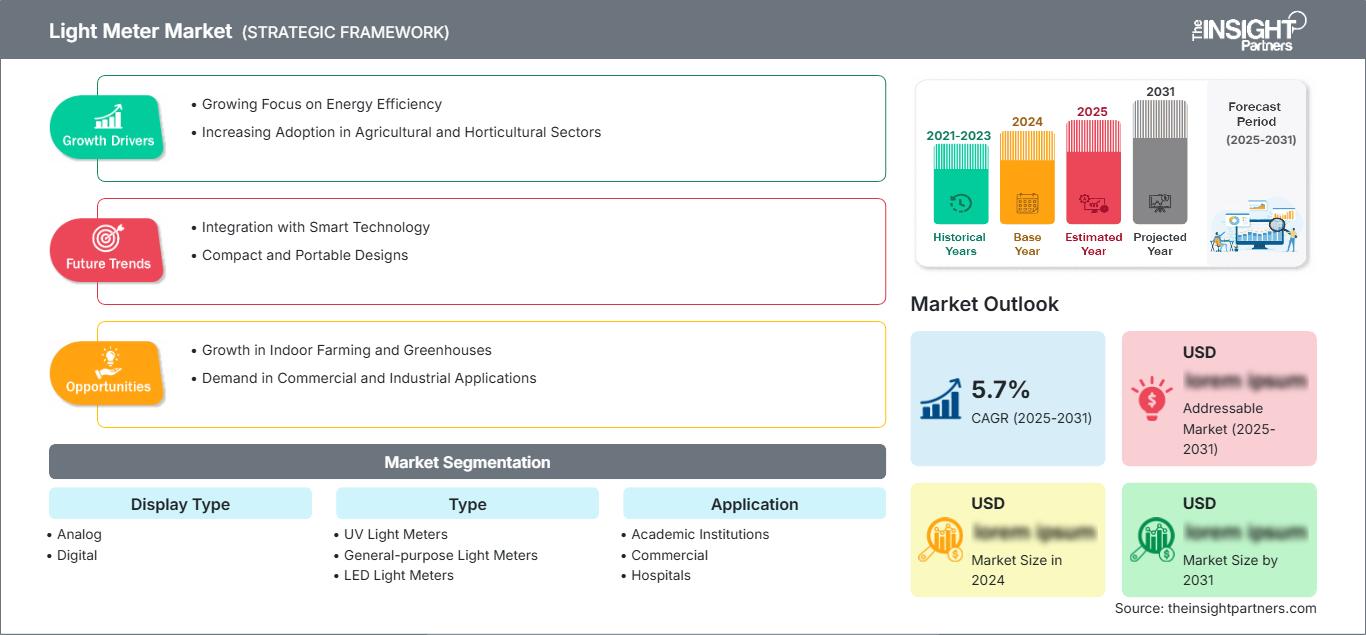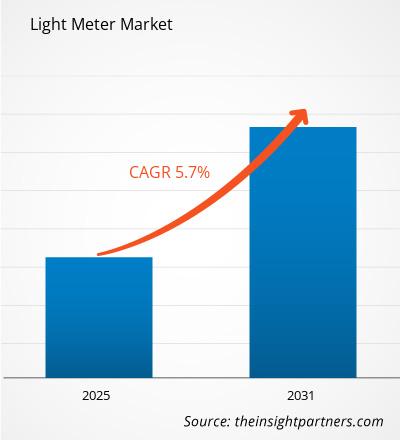Si prevede che il mercato dei misuratori di luce registrerà un CAGR del 5,7% dal 2025 al 2031, con una dimensione del mercato in espansione da XX milioni di dollari nel 2024 a XX milioni di dollari entro il 2031.
Il rapporto è segmentato per tipo di display (analogico, digitale); tipo (misuratori di luce UV, misuratori di luce per uso generale, misuratori di luce LED); applicazione (istituzioni accademiche, commerciali, ospedali, stabilimenti di produzione e magazzini, fotografia e cinematografia, altri). L'analisi globale è ulteriormente suddivisa a livello regionale e per i principali paesi. Il rapporto offre il valore in USD per l'analisi e i segmenti sopra indicati.
Scopo del rapporto
Il rapporto "Light Meter Market" di The Insight Partners mira a descrivere il panorama attuale e la crescita futura, i principali fattori trainanti, le sfide e le opportunità. Ciò fornirà spunti a vari stakeholder aziendali, come:
- Fornitori/produttori di tecnologia: per comprendere le dinamiche di mercato in evoluzione e conoscere le potenziali opportunità di crescita, consentendo loro di prendere decisioni strategiche informate.
- Investitori: per condurre un'analisi completa delle tendenze in merito al tasso di crescita del mercato, alle proiezioni finanziarie del mercato e alle opportunità esistenti lungo la catena del valore.
- Organismi di regolamentazione: per regolamentare le politiche e le attività di controllo nel mercato con l'obiettivo di ridurre al minimo gli abusi, preservare la fiducia degli investitori e sostenere l'integrità e la stabilità del mercato.
Segmentazione del mercato dei misuratori di luce Tipo di display
- Analogico
- Digitale
Tipo
- Misuratori di luce UV
- Misuratori di luce per uso generico
- Misuratori di luce LED
Applicazione
- Istituzioni accademiche
- Commerciali
- Ospedali
- Impianti di produzione e magazzini
- Fotografia e cinematografia
- Altri
Geografia
- Nord America
- Europa
- Asia-Pacifico
- Sud e Centro America
- Medio Oriente e Africa
Potrai personalizzare gratuitamente qualsiasi rapporto, comprese parti di questo rapporto, o analisi a livello di paese, pacchetto dati Excel, oltre a usufruire di grandi offerte e sconti per start-up e università
Mercato dei misuratori di luce: Approfondimenti strategici

-
Ottieni le principali tendenze chiave del mercato di questo rapporto.Questo campione GRATUITO includerà l'analisi dei dati, che vanno dalle tendenze di mercato alle stime e alle previsioni.
Fattori di crescita del mercato dei misuratori di luce
- Crescente attenzione all'efficienza energetica: la crescente attenzione globale all'efficienza energetica e alle pratiche sostenibili è un fattore chiave per il mercato dei misuratori di luce. I misuratori di luce aiutano aziende, governi e consumatori a monitorare e ottimizzare il consumo energetico fornendo letture accurate dell'intensità luminosa in diversi contesti. Ciò supporta misure di risparmio energetico in settori come l'edilizia commerciale, l'agricoltura e l'illuminazione esterna, stimolando la domanda di soluzioni di misuratori di luce più avanzate.
- Crescente adozione nei settori agricolo e orticolo: la necessità di misurazioni precise della luce in agricoltura e orticoltura sta alimentando la crescita del mercato. I misuratori di luce sono fondamentali per controllare l'ambiente luminoso per una crescita ottimale delle piante, soprattutto nell'agricoltura indoor e nelle serre. Con la crescente popolarità dell'agricoltura verticale e dell'agricoltura in ambiente controllato, si prevede un aumento della domanda di misuratori di luce per monitorare e regolare l'esposizione alla luce.
Tendenze future del mercato dei misuratori di luce
- Integrazione con tecnologie intelligenti: una tendenza crescente nel mercato dei misuratori di luce è l'integrazione dei misuratori di luce con l'IoT e le tecnologie intelligenti. I misuratori di luce moderni sono ora dotati di connettività wireless, che consente la trasmissione dei dati in tempo reale, il monitoraggio remoto e le regolazioni automatiche. Questa integrazione offre agli utenti maggiore praticità e informazioni più accurate sulle condizioni di luce, soprattutto in edifici intelligenti, uffici e ambienti industriali.
- Design compatti e portatili: si sta assistendo a una tendenza verso misuratori di luce più compatti e portatili, trainata dalla domanda di dispositivi portatili facili da usare per i professionisti di settori come la fotografia, l'orticoltura e l'edilizia. Questi misuratori più piccoli e leggeri offrono un'elevata precisione in un formato pratico, rendendoli sempre più popolari tra i tecnici sul campo e i professionisti del settore.
Opportunità di mercato per i misuratori di luce
- Crescita nell'agricoltura indoor e nelle serre: con l'aumento dell'agricoltura indoor e dell'agricoltura in ambiente controllato, si apre un'importante opportunità per il mercato dei misuratori di luce. Questi ambienti richiedono un controllo preciso delle condizioni di luce per una crescita ottimale delle piante, presentando una crescente necessità di strumenti di misurazione della luce accurati e affidabili. L'espansione di questo settore offre un'opportunità promettente per i produttori di misuratori di luce.
- Domanda nelle applicazioni commerciali e industriali: i settori commerciale e industriale stanno adottando sempre più misuratori di luce per la progettazione, la manutenzione e la conformità alle normative dell'illuminazione. Una corretta misurazione della luce è fondamentale per garantire sicurezza, produttività ed efficienza energetica nei luoghi di lavoro, nei magazzini e nelle fabbriche. Con l'inasprimento delle normative sugli standard di illuminazione, si prevede una crescita della domanda di misuratori di luce in questi settori.
Approfondimenti regionali sul mercato dei misuratori di luce
Le tendenze regionali e i fattori che influenzano il mercato dei misuratori di luce durante il periodo di previsione sono stati ampiamente spiegati dagli analisti di The Insight Partners. Questa sezione illustra anche i segmenti e la geografia del mercato dei misuratori di luce in Nord America, Europa, Asia-Pacifico, Medio Oriente e Africa, America Meridionale e Centrale.
Ambito del rapporto di mercato dei misuratori di luce
| Attributo del rapporto | Dettagli |
|---|---|
| Dimensioni del mercato in 2024 | US$ XX million |
| Dimensioni del mercato per 2031 | US$ XX Million |
| CAGR globale (2025 - 2031) | 5.7% |
| Dati storici | 2021-2023 |
| Periodo di previsione | 2025-2031 |
| Segmenti coperti |
By Tipo di display
|
| Regioni e paesi coperti |
Nord America
|
| Leader di mercato e profili aziendali chiave |
|
Densità degli operatori del mercato dei misuratori di luce: comprendere il suo impatto sulle dinamiche aziendali
Il mercato dei misuratori di luce è in rapida crescita, trainato dalla crescente domanda degli utenti finali, dovuta a fattori quali l'evoluzione delle preferenze dei consumatori, i progressi tecnologici e una maggiore consapevolezza dei vantaggi del prodotto. Con l'aumento della domanda, le aziende stanno ampliando la propria offerta, innovando per soddisfare le esigenze dei consumatori e sfruttando le tendenze emergenti, alimentando ulteriormente la crescita del mercato.

- Ottieni il Mercato dei misuratori di luce Panoramica dei principali attori chiave
Punti di forza
- Copertura completa: il rapporto analizza in modo esaustivo prodotti, servizi, tipologie e utenti finali del mercato dei misuratori di luce, offrendo una panoramica olistica.
- Analisi degli esperti: il rapporto è redatto sulla base della conoscenza approfondita di esperti e analisti del settore.
- Informazioni aggiornate: il rapporto garantisce la pertinenza aziendale grazie alla copertura di informazioni e tendenze dei dati recenti.
- Opzioni di personalizzazione: questo rapporto può essere personalizzato per soddisfare le esigenze specifiche del cliente e adattarsi in modo appropriato alle strategie aziendali.
Il rapporto di ricerca sul mercato dei misuratori di luce può quindi contribuire a guidare il percorso di decodificazione e comprensione dello scenario del settore e delle prospettive di crescita. Sebbene possano esserci alcune valide preoccupazioni, i vantaggi complessivi di questo rapporto tendono a superare gli svantaggi.
- Analisi storica (2 anni), anno base, previsione (7 anni) con CAGR
- Analisi PEST e SWOT
- Valore/volume delle dimensioni del mercato - Globale, Regionale, Nazionale
- Industria e panorama competitivo
- Set di dati Excel
Report recenti
Testimonianze
Motivo dell'acquisto
- Processo decisionale informato
- Comprensione delle dinamiche di mercato
- Analisi competitiva
- Analisi dei clienti
- Previsioni di mercato
- Mitigazione del rischio
- Pianificazione strategica
- Giustificazione degli investimenti
- Identificazione dei mercati emergenti
- Miglioramento delle strategie di marketing
- Aumento dell'efficienza operativa
- Allineamento alle tendenze normative






















 Ottieni un campione gratuito per - Mercato dei misuratori di luce
Ottieni un campione gratuito per - Mercato dei misuratori di luce